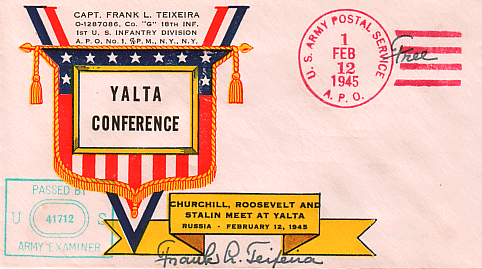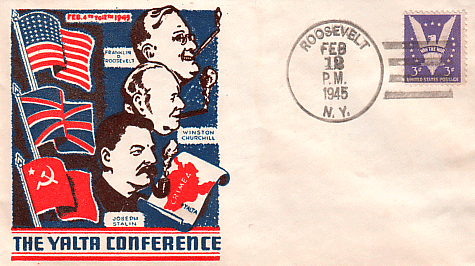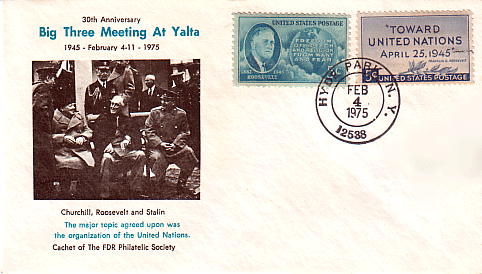
 |
This
cover was produced by
Fidelity Stamp Company of Washington, D.C. It was postmarked in the
capital city on February 7, 1945, the first day word of the conference
was made public.
Fidelity was a consistent producer of event covers during the war. |
| This cover was produced
by U.S. Army Capt. Frank L. Teixeira,
who designed and published 34 patriotic covers during the war. This is
a typical Teixeira cover with his corner card, his signature as censor,
and an APO 1 postmark over his free frank. |
 |
 |
Like the Teixeira cover,
this cover is postmarked February
12, 1945, the day after the conference concluded and the world press
was given details of the meeting. This cover was postmarked in
Roosevelt, New York. The cachet maker is unconfirmed; some sources
credit Smart Craft as the producer. As a reminder of a different era,
note that each Allied leader is depicted with his tobacco product of
choice--FDR with a cigarette, Churchill with his trademark cigar, and
Stalin with a pipe. Imagine seeing that today! |
| As mentioned above, one
of the more tangible results of the
Yalta conference was the agreement to establish the United Nations.
That meeting began April 25, 1945 in San Francisco, and the U.S. issued
a stamp that day to mark the occasion. In the wake of Roosevelt's death
on April 12, the stamp was hastily revised to add his name, becoming a
quasi-memorial issue. This cover, a second-day cover postmarked in
Washington, features an Art Craft cachet with a photo of the Big Three
at
Yalta. Using a photo in a cachet was a significant departure for Art
Craft; most Art Craft cachets then and now are original works of art. |
 |
 |
This first day cover for
the 1974 British Churchill Centenary
stamps was produced by Colorano, with a "silk" cachet of the Big Three
at Yalta. |
| This is an amusing
cover, produced by the International Stamp
Collectors Society for the 100th anniversary of Churchill's birth. Note
that WSC and FDR have been lifted out of a Yalta conference photograph
and deposited into some kind of garden. Bad guy Stalin was left behind.
Ironically, this kind of photographic fakery is worthy of a Soviet
propagandist, not a stamp club. |
 |
 |
This cover notes the
30th anniversary of the Yalta
conference. The cover was produced by the now-defunct FDR Philatelic
Society and was postmarked in Hyde Park, New York, location of
Roosevelt's home and final resting place. |
| This cover marks the
45th anniversary of the Yalta meeting.
It was produced by Merchandising Corporation of America, Inc., in
conjunction with The New York Times.
The cover was
sold with a mounting page that reproduced the front page of the
February 13, 1945 issue of the newspaper, which carried a report of the
conference. |
 |
 |
The Marshall Islands issued a Yalta stamp in their World War II anniversary series. |
| A first day cover from Russia, with their 1995 World War II anniversary stamps, postmarked in Moscow on May 8 (the 50th anniversary of V-E Day). A Russian stamp featuring Churchill and Roosevelt (and Stalin for that matter) would certainly not have been issued during the Soviet era. |  |
 |
My final Yalta cover is
a special one, postmarked in Livadiya (Yalta) on the 50th anniversary
of the conference, and sent to Poltava, Ukraine. The postmark at the
foot of the cover is an unchanged USSR handstamp (note the "CCCP" at
the top). It was not uncommon in the first few years after the 1991
dissolution of the USSR for old postmarking devices to remain in use.
Perhaps use of an old USSR postmark was intentional in
Crimea, as the population is generally Russian-speaking, not Ukrainian. |